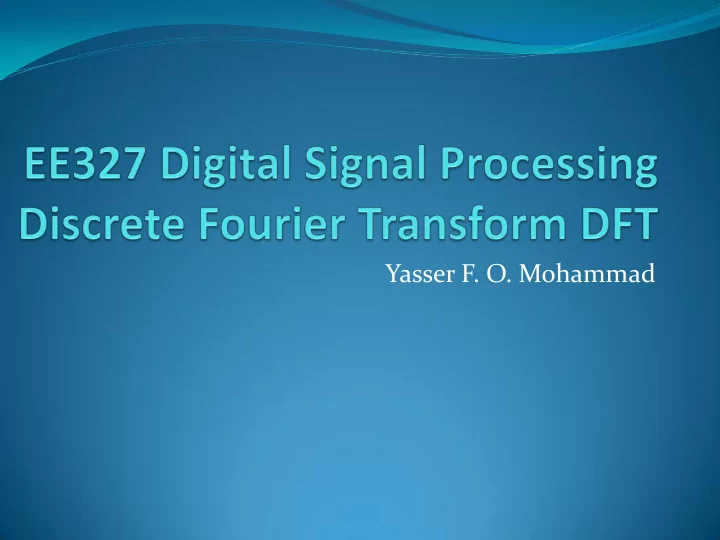

Yasser F. O. Mohammad
REMINDER 1: Common Impulse Responses Identity System: x n n x n Amplifier/Attenuator: x n k n k x n x n n s x n s Delay/Shift: x n n n s x n x n s Echo:
REMINDER 2: Discretizing Calculus First Difference : y n x n x n [ ] [ ] [ 1] Discrete equivalent of differentiation Discrete Derivative Running Sum: n y n [ ] x i [ ] x n [ ] y n [ 1] i 0 Discrete equivalent of integration Discrete Integral
REMINDER 3: Properties of Convolution Commutative Property: a n b n b n a n [ ]* [ ] [ ]* [ ] Associative Property: a n [ ]* b n [ ]* [ ] c n a n [ ]* [ ] * [ ] b n c n
Now What? We can analyze systems in time domain using impulse response and convolution We will look at how to do the same thing in the frequency domain using Fourier analysis and just multiplication. Why? More insight (sometimes) Faster (sometimes)
What is a transform A multi-input multi-output function We use it to see the data from a different prespective Examples: Fourier transform Laplace transform Z transform Discrete Cosine Transform etc
Types of Fourier Decompositions
Fourier Decomposition Periodic Time Domain Discrete Frequency Domain Discrete Time Domain Periodic Frequency Domain Periodicity Periodic aperiodic continuous Fourier Series Fourier Transform FS FT Continuity Aperiodic Spectrum Aperiodic Spectrum Discrete Spectrum Continuous Spectrum discrete Discrete Fourier Transform Discrete Time Fourier Transform DFT DTFT Periodic Spectrum Periodic Spectrum Discrete Spectrum Continuous Spectrum
Finite or infinite Sine/cosine waves are infinite In DSP we have finite signals Finite signals cannot be decomposed to infinite parts!! What can we do? Pad by zeros to infinity Use DTFT (by the end of this course) Assume the signal is periodic with period N Use DFT (easier)
A point to remember When using DFT we assume that the signal we decompose is infinite and PERIODIC and that the period is N
Discrete Fourier Transform Usually N is a power of 2 (to use FFT)
Notation Time Domain Signal: Lower case letters (e.g. x,y,z) Complex Frequency Domain Signal: Upper case letters (e.g. X, Y, Z) Real part of the frequency domain signal: Re X, Re Y, Re Z Imaginary part of the frequency domain signal: Im X, Im Y, Im Z
Example DFT Time Domain : 0 N Frequency Domain: k : 0 N/2 f : 0 0.5 ω: 0 π f is a fraction of f s
How to use the three notations x[n]= cos(2 π kn/N) x[n]= cos(2 π f n) x[n]= cos( ω n) This means: f =k/N ω=2π f
DFT basis functions c k [n]= cos(2 π kn/N) s k [n]= sin(2 π kn/N)
A puzzle for you Input is N points Output is 2*(N/2+1) = N +2 Where did the extra two points come from??? Solution ImX[0]=ImX[N/2]=0 Why? They represent a signal of all zeros that cannot affect the time domain
Synthesis Equation From Frequency domain to Time domain
Calculating Inverse DFT
Why the 2/N, 1/N factors Frequency domain signals in DFT are defined as spectral density Spectral Density: How much signal (amplitude) exists per unit bandwidth Total bandwidth of discrete signals = N/2 (Nyquist) Bandwidth of every point is 2/N except first and last
Forward DFT Three solutions N equations in N variables Correlation Fast Fourier Transform
DFT by N equations Each value of i gives one equation. Remember that ImX[0]=ImX[N/2]=0 We need N more equations Hence, each of ReX and ImX will be N/2+1 as expected All equations must be linearly independent
DFT by correlation Find the correlation between the basis function and the signal The average of this correlation is the required amplitude. For this to work all basis functions must have zero correlation. Sins and Cosines of different frequency have zero correlation
DFT by Correlation Example Correlation is 0.5
DFT by Correlation Example 2 Correlation is zero
Calculating DFT
Duality sine in the time domain single point in frequency domain sine in the frequency domain single point in time domain Convolution in time domain multiplication in frequency domain Convolution in frequency domain multiplication in time domain
Rectangular and Polar Notations
Conversion Formulas
Example
When to use what? Rectangular form is usually used for calculations Polar form is usually used for display Sinusoidal fidelity means that the only changes possible to a sinusoidal are phase shifts and amplitude scaling These are clear in the polar form
Conversion algorithm
Notes on Polar form As defined all phases are in radians not degrees Remember not to divide by zero when ReX[i]=0 Calculating phase: ReX ImX Correction + + 0 + - 0 - + + π - - - π
Notes on Polar form Very small amplitudes cause large noise in the phase (- π π ) Phase wrapping (2 π ambiguity) Solution: unwrapping
Apparent discontinuity of phase
Recommend
More recommend